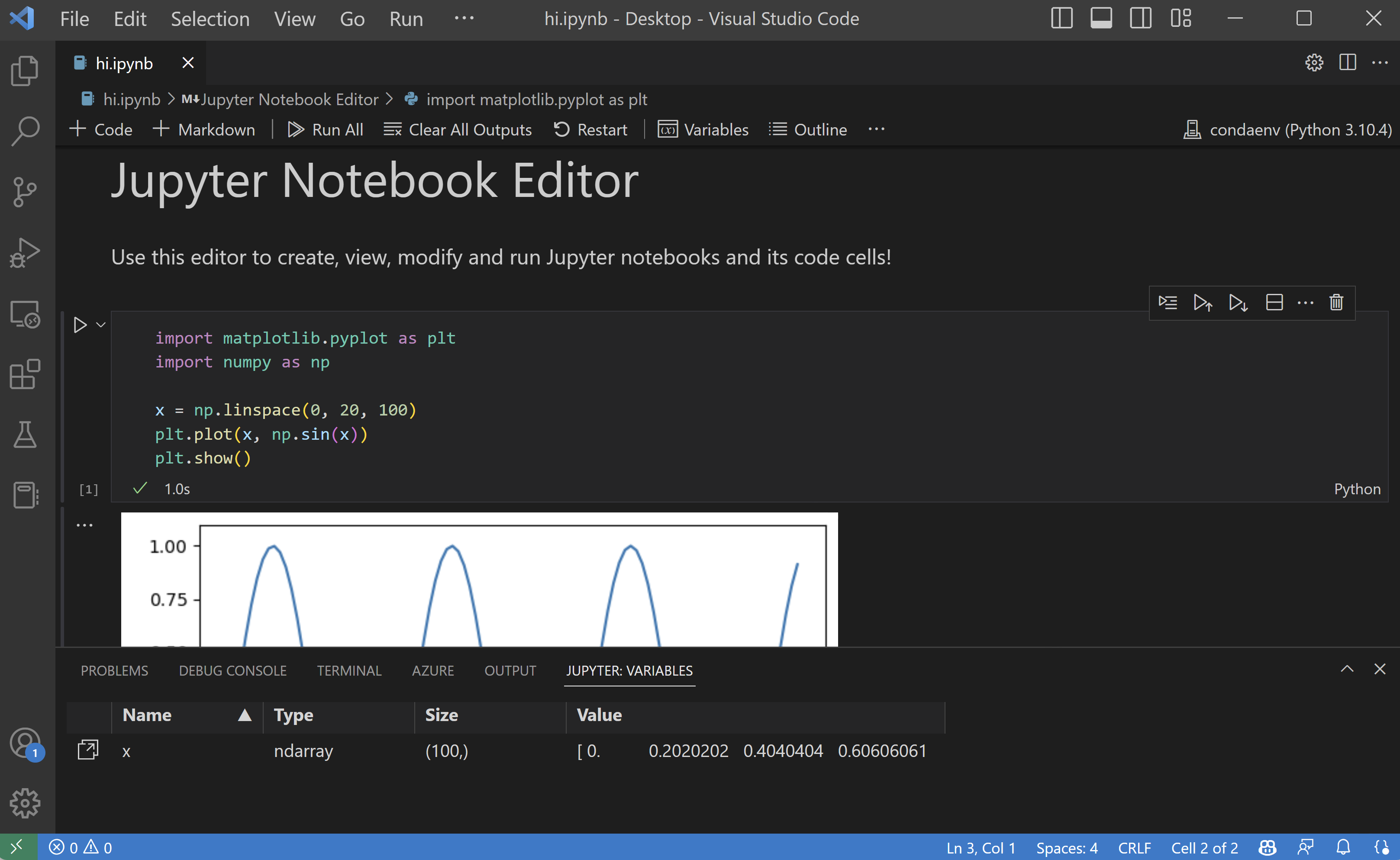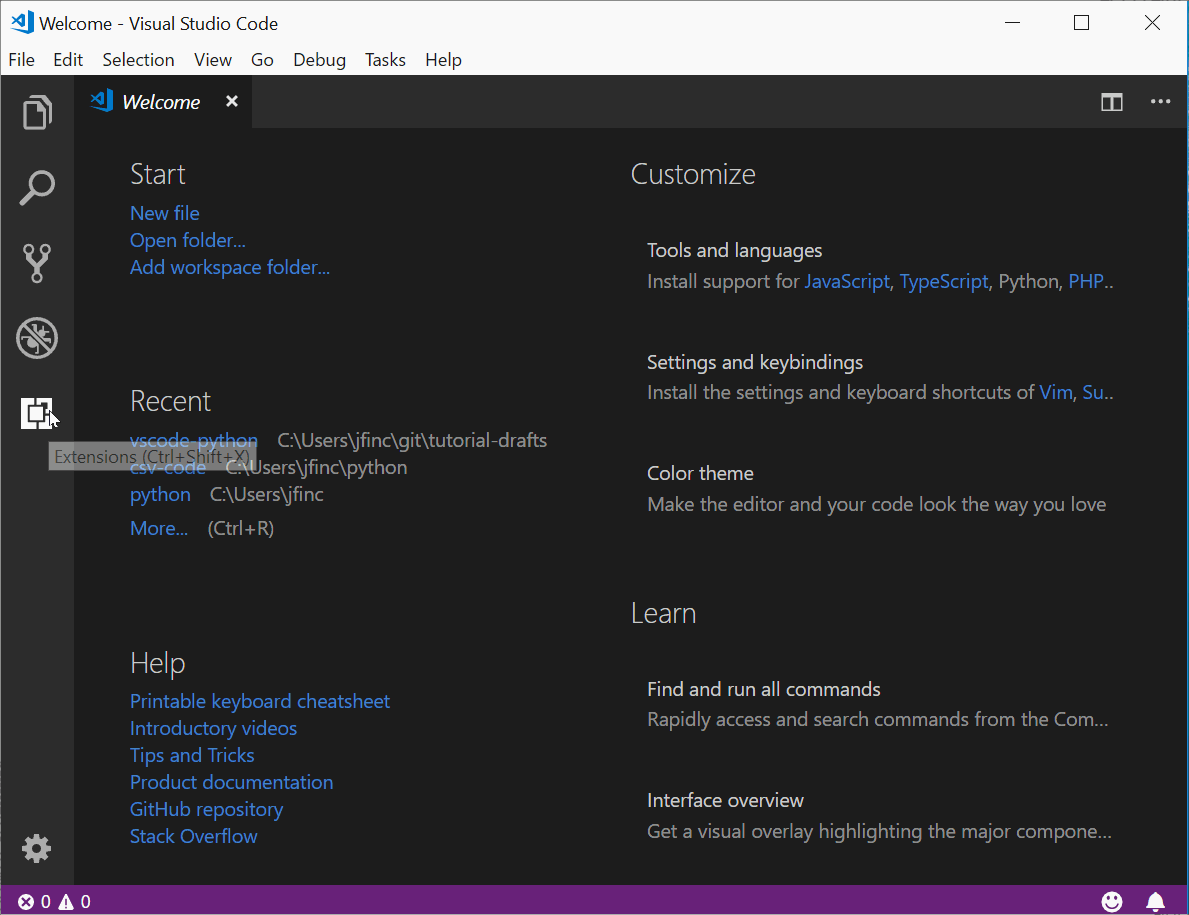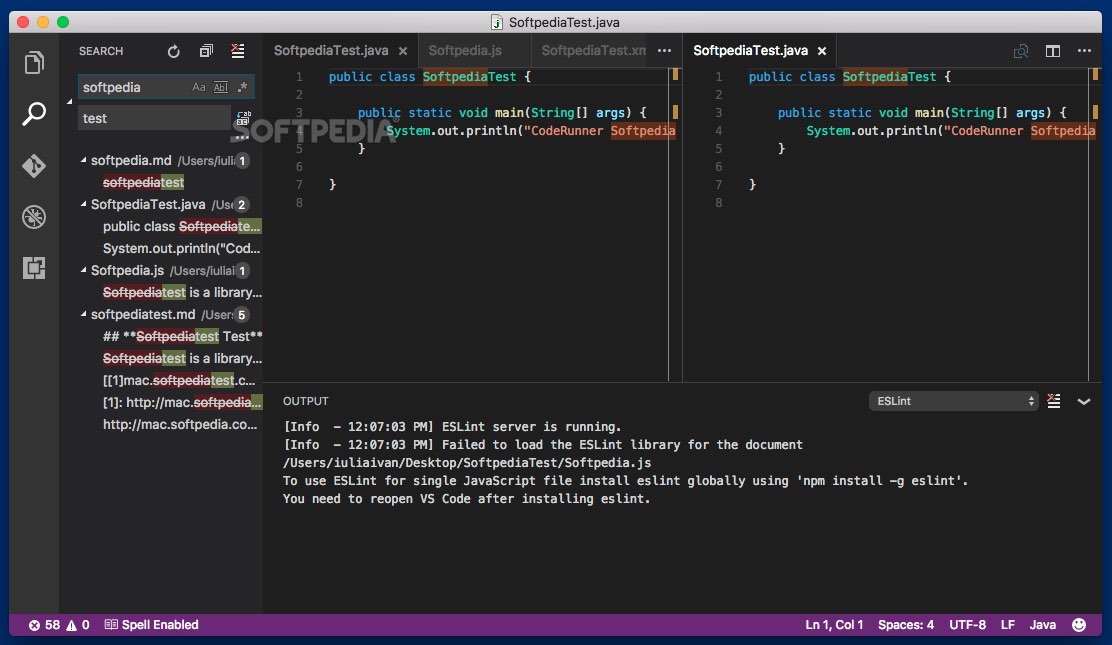Python support is presently available only on Visual Studio for Windows; on Mac and Linux, Python support is available through Visual Studio Code. Download and run the latest Visual Studio installer for Windows (Python support is present in release 15.2 and later). Visual Studio Code on macOS Installation. Download Visual Studio Code for macOS. Open the browser's download list and locate the downloaded archive. Select the 'magnifying glass' icon to open the archive in Finder. Drag Visual Studio Code.app to the Applications folder, making it.
After reading this, you will be able to execute python files and jupyter notebooks that execute Apache Spark code in your local environment. This tutorial applies to OS X and Linux systems. We assume you already have knowledge on python and a console environment.
1. Download Apache Spark
We will download the latest version currently available at the time of writing this: 3.0.1 from the official website.
Download it and extract it in your computer. The path I'll be using for this tutorial is /Users/myuser/bigdata/spark This folder will contain all the files, like this
Now, I will edit the .bashrc file, located in the home of your user
Then we will update our environment variables so we can execute spark programs and our python environments will be able to locate the spark libraries.
Save the file and load the changes executing $ source ~/.bashrc. If this worked, you will be able to open an spark shell.
We are now done installing Spark.
2. Install Visual Studio Code
One of the good things of this IDE is that allows us to run Jupyter notebooks within itself. Follow the Set-up instructions and then install python and the VSCode Python extension.
Then, open a new terminal and install the pyspark package via pip $ pip install pyspark. Note: depending on your installation, the command changes to pip3.
3. Run your pyspark code
Create a new file or notebook in VS Code and you should be able to execute and get some results using the Pi example provided by the library itself.
Troubleshoot
If you are in a distribution that by default installs python3 (e.g. Ubuntu 20.04), pyspark will mostly fail with a message error like pysparkenv: 'python': No such file or directory.
The first option to fix it is to add to your .profile or .bashrc files the following content
Remember to always reload the configuration via source .bashrc
In this case, the solution worked if I executed pyspark from the command line but not from VSCode's notebook. Since I am using a distribution based on debian, installing tehe following package fixed it:
sudo apt-get install python-is-python3
Dear Readers,
In this post, I will explain steps to Install Visual Studio Code and the Python Extension on MAC.
+

We need three things to install Visual Studio Code and the Python Extension on MAC
- VS Code
- VS Code Python extension
- Python 3
Step 1 – Install VS Code
1. Go To URL https://code.visualstudio.com
2. Click Download for MAC
3. Unzip the file you will get “Visual Studio Code.app”. Double click.
4. Click Open if below mentioned window pops up
Step 2 – Install Python Extension for VS Code
- Next, install the Python extension for VS Code from the Visual Studio Marketplace.
2. Click Continue – Visual Studio Code is required to install the extension
3. Click Open Visual Studio Code after clicking the optional checkbox for always allowing the market place to open visual studio code.
4. Click OK
5. Click Install
>> Installing
>> Installed
>> You may see this error in the bottom
Step 3 – Install a Python interpreter
Along with the Python extension, you need to install a Python interpreter. Which interpreter you use is dependent on your specific needs, but some guidance is provided below.
1. On macOS, make sure the location of your VS Code installation is included in your PATH environment variable.
Click “Command + Shift + P”
On the search tab – type ” shell command” > Install code command in path will appear – click on that
Click OK
Enter Password
The system install of Python on macOS is not supported. Instead, an installation through Homebrew is recommended.
2. Install Homebrew
To install Home Brew in MAC- Run this command on terminal
Enter password
Once it is installed, you will see below messages
Step 4 Install Python
To install Python using Homebrew on macOS use brew install python at the Terminal prompt.
Step 5 Verify the Python installation
To verify that you’ve installed Python successfully on your machine, run one of the following command :
python3 –version
If the installation was successful, the output window should show the version of Python that you installed.
I faced a issue here – It was showing old version of my python
I used below command to resolve it, but unsuccessful
$ brew install pyenv
$ pyenv install 3.8.5
$ pyenv global 3.8.5
$ pyenv version
It was again showing the same version
Now I tried
brew link python@3.8
It was showing error – so I removed few files
rm ‘/usr/local/bin/2to3’
rm ‘/usr/local/bin/idle3’
rm ‘/usr/local/bin/pydoc3’
rm ‘/usr/local/bin/python3’
rm ‘/usr/local/bin/python3-config’
Python Tools Visual Studio 2017
And finally I run the command again and it was successful
ravidubey@Ravis-MacBook-Pro ~ % brew link python@3.8
Linking /usr/local/Cellar/python@3.8/3.8.5… 25 symlinks created
ravidubey@Ravis-MacBook-Pro ~ % python3 –version Displaylink input devices driver download.
Python 3.8.5
Step 6 Start VS Code in a project (workspace) folder
Using a command prompt or terminal, create an empty folder called “hello”, navigate into it, and open VS Code (code) in that folder (.) by entering the following commands:
In case you face issue, run this command –
- Move Visual Studio .app file from any location to application folder
- Remove the current link with
sudo rm /usr/local/bin/code - Start Visual Studio from within
/Applications - Now open the Command Palette (F1 or ⇧⌘P on Mac) and type
shell commandto find theShell Command: Install 'code' command in PATHcommand.
By starting VS Code in a folder, that folder becomes your “workspace”. VS Code stores settings that are specific to that workspace in .vscode/settings.json, which are separate from user settings that are stored globally.
Alternately, you can run VS Code through the operating system UI, then use File > Open Folder to open the project folder.
Step 7 Select a Python interpreter
Python is an interpreted language, and in order to run Python code and get Python IntelliSense, you must tell VS Code which interpreter to use.
From within VS Code, select a Python 3 interpreter by opening the Command Palette (⇧⌘P), start typing the Python: Select Interpreter command to search, then select the command. You can also use the Select Python Environment option on the Status Bar if available (it may already show a selected interpreter, too):
The command presents a list of available interpreters that VS Code can find automatically, including virtual environments. If you don’t see the desired interpreter, see Configuring Python environments.
Visual Studio For Mac Python Development
Note: When using an Anaconda distribution, the correct interpreter should have the suffix ('base':conda), for example Python 3.7.3 64-bit ('base':conda)
Selecting an interpreter sets the python.pythonPath value in your workspace settings to the path of the interpreter. To see the setting, select File > Preferences > Settings (Code > Preferences > Settings on macOS), then select the Workspace Settings tab.
Note: If you select an interpreter without a workspace folder open, VS Code sets python.pythonPath in your user settings instead, which sets the default interpreter for VS Code in general. The user setting makes sure you always have a default interpreter for Python projects. The workspace settings lets you override the user setting.
Step 8 Create a Python Hello World source code file
From the File Explorer toolbar, select the New File button on the hello folder:
Name the file hello.py, and it automatically opens in the editor:
By using the .py file extension, you tell VS Code to interpret this file as a Python program, so that it evaluates the contents with the Python extension and the selected interpreter.
Note: The File Explorer toolbar also allows you to create folders within your workspace to better organize your code. You can use the New folder button to quickly create a folder.
Now that you have a code file in your Workspace, enter the following source code in hello.py:
When you start typing print, notice how IntelliSense presents auto-completion options.
IntelliSense and auto-completions work for standard Python modules as well as other packages you’ve installed into the environment of the selected Python interpreter. It also provides completions for methods available on object types. For example, because the msg variable contains a string, IntelliSense provides string methods when you type msg.:
Feel free to experiment with IntelliSense some more, but then revert your changes so you have only the msg variable and the print call, and save the file (⌘S).
For full details on editing, formatting, and refactoring, see Editing code. The Python extension also has full support for Linting.
You may have to install pylint using the command
brew install pylint
Step 9 Run Hello World
It’s simple to run hello.py with Python. Just click the Run Python File in Terminal play button in the top-right side of the editor.
The button opens a terminal panel in which your Python interpreter is automatically activated, then runs python3 hello.py (macOS/Linux) or python hello.py (Windows):
There are three other ways you can run Python code within VS Code:

- Right-click anywhere in the editor window and select Run Python File in Terminal (which saves the file automatically):
- Select one or more lines, then press Shift+Enter or right-click and select Run Selection/Line in Python Terminal. This command is convenient for testing just a part of a file.
- From the Command Palette (⇧⌘P), select the Python: Start REPL command to open a REPL terminal for the currently selected Python interpreter. In the REPL, you can then enter and run lines of code one at a time.
Step 10 Configure and run the debugger#
Let’s now try debugging our simple Hello World program.
First, set a breakpoint on line 2 of hello.py by placing the cursor on the print call and pressing F9. Alternately, just click in the editor’s left gutter, next to the line numbers. When you set a breakpoint, a red circle appears in the gutter.
Next, to initialize the debugger, press F5. Since this is your first time debugging this file, a configuration menu will open from the Command Palette allowing you to select the type of debug configuration you would like for the opened file.
Note: VS Code uses JSON files for all of its various configurations; launch.json is the standard name for a file containing debugging configurations.
These different configurations are fully explained in Debugging configurations; for now, just select Python File, which is the configuration that runs the current file shown in the editor using the currently selected Python interpreter.

The debugger will stop at the first line of the file breakpoint. The current line is indicated with a yellow arrow in the left margin. If you examine the Local variables window at this point, you will see now defined msg variable appears in the Local pane.
A debug toolbar appears along the top with the following commands from left to right: continue (F5), step over (F10), step into (F11), step out (⇧F11), restart (⇧⌘F5), and stop (⇧F5).
Visual Studio Python Machine Learning
The Status Bar also changes color (orange in many themes) to indicate that you’re in debug mode. The Python Debug Console also appears automatically in the lower right panel to show the commands being run, along with the program output.
To continue running the program, select the continue command on the debug toolbar (F5). The debugger runs the program to the end.
Tip Debugging information can also be seen by hovering over code, such as variables. In the case of msg, hovering over the variable will display the string Hello world in a box above the variable.
You can also work with variables in the Debug Console (If you don’t see it, select Debug Console in the lower right area of VS Code, or select it from the … menu.) Then try entering the following lines, one by one, at the > prompt at the bottom of the console:
Select the blue Continue button on the toolbar again (or press F5) to run the program to completion. “Hello World” appears in the Python Debug Console if you switch back to it, and VS Code exits debugging mode once the program is complete.
If you restart the debugger, the debugger again stops on the first breakpoint.
To stop running a program before it’s complete, use the red square stop button on the debug toolbar (⇧F5), or use the Run > Stop debugging menu command.
For full details, see Debugging configurations, which includes notes on how to use a specific Python interpreter for debugging.
Visual Studio Code Python For Mac
Tip: Use Logpoints instead of print statements: Developers often litter source code with print statements to quickly inspect variables without necessarily stepping through each line of code in a debugger. In VS Code, you can instead use Logpoints. A Logpoint is like a breakpoint except that it logs a message to the console and doesn’t stop the program. For more information, see Logpoints in the main VS Code debugging article.
Step 11 Install and use packages
Let’s now run an example that’s a little more interesting. In Python, packages are how you obtain any number of useful code libraries, typically from PyPI. For this example, you use the matplotlib and numpy packages to create a graphical plot as is commonly done with data science. (Note that matplotlib cannot show graphs when running in the Windows Subsystem for Linux as it lacks the necessary UI support.)
Return to the Explorer view (the top-most icon on the left side, which shows files), create a new file called standardplot.py, and paste in the following source code:
Tip: If you enter the above code by hand, you may find that auto-completions change the names after the as keywords when you press Enter at the end of a line. To avoid this, type a space, then Enter.
Next, try running the file in the debugger using the “Python: Current file” configuration as described in the last section.

Unless you’re using an Anaconda distribution or have previously installed the matplotlib package, you should see the message, “ModuleNotFoundError: No module named ‘matplotlib'”. Such a message indicates that the required package isn’t available in your system.
To install the matplotlib package (which also installs numpy as a dependency), stop the debugger and use the Command Palette to run Terminal: Create New Integrated Terminal (⌃⇧`). This command opens a command prompt for your selected interpreter.
Install Python Visual Studio
A best practice among Python developers is to avoid installing packages into a global interpreter environment. You instead use a project-specific virtual environment that contains a copy of a global interpreter. Once you activate that environment, any packages you then install are isolated from other environments. Such isolation reduces many complications that can arise from conflicting package versions. To create a virtual environment and install the required packages, enter the following commands as appropriate for your operating system:
Note: For additional information about virtual environments, see Environments.
- Create and activate the virtual environment Note: When you create a new virtual environment, you should be prompted by VS Code to set it as the default for your workspace folder. If selected, the environment will automatically be activated when you open a new terminal.
- For macOS/Linux
python3 -m venv .venv - Run command in the folder
source .venv/bin/activate - Select your new environment by using the Python: Select Interpreter command from the Command Palette.
- Install the packages
# python3 -m pip install matplotlib - Rerun the program now (with or without the debugger) and after a few moments a plot window appears with the output:
- Once you are finished, type
deactivatein the terminal window to deactivate the virtual environment.
Ref – https://code.visualstudio.com/docs/python/python-tutorial
